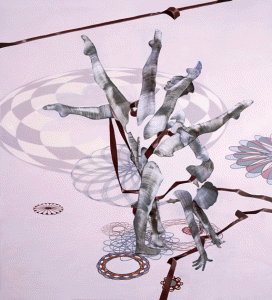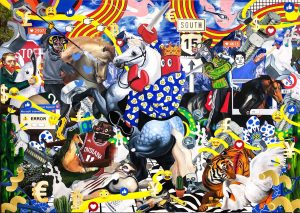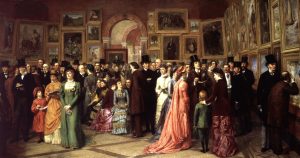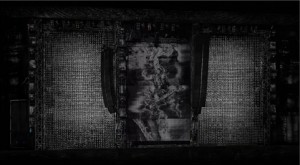
Private View: Thursday 18 September 18.00-21.00
Vegas Gallery 64 – 66 Redchurch Street LONDON E2 7DPwww.vegasgallery.co.uk
An Urge to Merge
For his solo exhibition at Vegas Gallery, British artist Simon Willems will be showing several paintings which explore themes of escapism, vulnerability, and artificiality versus authenticity. The pieces bring together aesthetic strategies developed in ealier work; the use of reflective and highly textured surfaces, and detailed depictions of non-human subjects whose toy-like sheen challenges viewers’ attempts to project meaning and affect onto them. Willem’s themes and painterly techniques mesh into holograms that appear alternately and simultaneously as arbitrary combinations and painstakingly choreographed assemblages of imagery and ideas.
In Signature Tuning a Bojangles cowboy clown in ruffled ice cream clothing strums a shrunken guitar whose yellow electrical lead trails out of sight. Mouth height in the black field between the figure’s neck and the brim of its hat floats a white thumb sized face, grinning and wearing sunglasses. Wearing ruffled ice cream clothing reminiscent of a Velasquez court jester or a Watteau harlequin musician, Signature Tuning’s protagonist strums alone, marooned on a blue surface resembling liquid or a shiny showroom floor. Surrounding panels of paint hover on an abstract/figurative cusp. At a distance and through scrunched up eyes they connote infinite spaces; water, mountains, sky. The painting’s title insinuates a warm up before a performance of oneself. The performer is faceless and desultory, comical and sad. It is plugged into an invisible source, animated by an embedded Caucasian, fingerprint chip and wedged between ersatz terrains that promise and retract infinity, release, and a way out.
Signature Tuning encapsulates themes running through the exhibition, and Willem’s previous work, including a preoccupation with vulnerability as both tangible and a mirage. Vulnerability has become a buzz word associated with a wide buffet of contemporary alternative therapies, lifestyles, communities and aspirational spiritualities. These alternatives often offer visions of freedom and better places unfettered by the here and now, and assure reclamation of a truer, rawer self stripped of veneers. In this formula the topography of an uncorrupted out-there ignites the discovery of an uncorrupted essence. Jedi plays with these concepts, depicting a figure meditating cross legged on an imposing boulder totem that appears to have been formed from slabs or folds of plastic lava. The figure is a small blip on the tip of a rock (whose man made associations with nature, purity and timelessness are shrewdly undermined by the grain of the paint and Jedi’s science fiction title), vainly in search of spiritual nutrition and authenticity.
In another sense vulnerability is real and intrinsic to being alive. Willem’s menagerie of mythical, imagined and other-than-human subjects is a repository for everyday longing and fragility, reminding us that there are no guarantees against ridicule and uncertainty. But for all their pathos, these subjects seem unreal. They are often rendered in a distancing style which recalls airbrushed posters, and are literally or figuratively framed as caricatured images. Dinosaurs, for example, are a recurrent motif. Willems uses fibreglass dioramas, maquettes, soft toys and theme park models as source material for his dinosaur imagery, distilling it from layers of pseudo-scientific and tacky popular representations. Like basalt or mineral strata he plumbs synthetic, cuddly revisions of creatures from a time and place outside of human experience, in search of a core, unadulterated image we can only imagine. Along the way Willems pinpoints the poignant and powerful comfort of belief. Belief, his paintings seem to say, is a broken down theme park character or a plush toy in a Natural History museum gift shop. It is not enough and all we have; a threadbare blanket against loneliness and insecurity about our place in the scheme of things.
In The Above, a ghostly ladder diagonally bisects an empty room which might belong to an uninhabited house being prepared for occupation. The ladder stretches up to an area outside the canvas edge. Next to a doll’s house replica of a Peter Halley painting a gorilla’s face looks out from a frame mounted on a wall spackled with a texture that recalls swirling constellations. This mute and melancholy close-up sign posts the way to an unknown space, possibly heaven, which is out of bounds and prefaced by a blank waiting room. Kitsch appears in a different flavour in The Advantages of Failure, in which a Futurist gymnast and symmetrical spiragraph floor are executed with a nod to vintage computer graphics. The title is deliberately oblique, unsettling a clear reading of either it or the painting it refers to.
Willem’s current paintings combine tactile realism …with atomized applications of paint seen in other, more abstract works, creating new nets of emotion and data. They scrupulously exert a hard-to-pin-down quality that gracefully undermines “imagined harmonies and delusive utopias”.
Simon Willems graduated from the Royal College of Art in 2000. Since then he has exhibited widely throughout Europe, America and Asia in both Solo and Group exhibitions. Recent exhibitions have included solo shows at FRAC Auvergne in Clermont Ferrand- France , Galerie Polaris -Paris, Wallspace Gallery- New York, Mark Moore Gallery, Santa Monica and Percy Miller Gallery, London amongst others.







